Chapter 3 Understanding Quadrilaterals Ex 3.1
Question 1.
Given here are some figures :
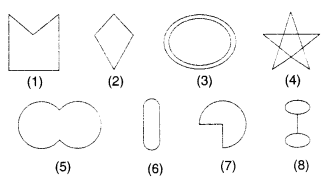
Classify each of them on the basis of the following :
- (a) Simple curve
- (b) Simple closed curve
- (c) Polygon
- (d) Convex polygon
- (e) Concave polygon
Solution.
(a) → 1, 2, 5, 6, 7
(b) →1, 2, 5, 6, 7
Question 2.
How many diagonals does each of the following have?
- (a) →A convex quadrilateral
- (b) →A regular hexagon
- (c) →A triangle.
Solution.
Question 3.
What is the sum of the measures of the angles of a convex quadrilateral? Will this property hold if the quadrilateral is not convex? (Make a non-convex
quadrilateral and j try!)
Solution.
The sum of the measures of the angles of a convex quadrilateral is 360°.
Yes! this property will hold if the; quadrilateral is not convex.
If the quadrilateral is not convex, then it will be concave.
Split the concave quadrilateral ABCD into two triangles ABD and CBD by joining BD.
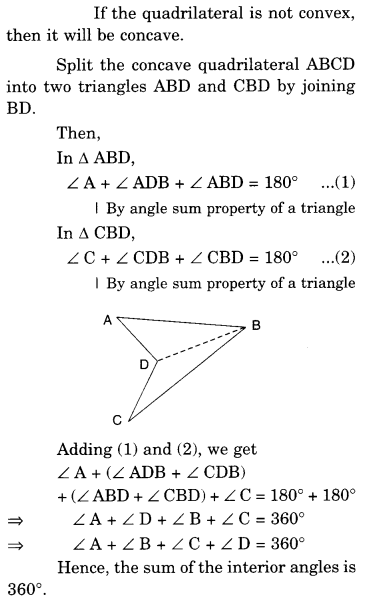
Question 4.
Examine the table. (Each figure is divided into triangles and the sum of the angles deduced from that.)

What can you say about the angle sum of a convex polygon with number of sides ?
Solution.
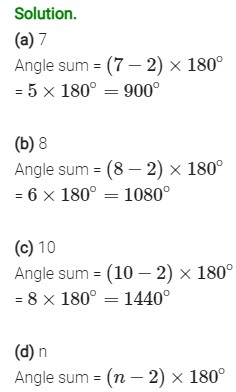
Question 5.
What is a regular polygon? State the name of a regular polygon of
- (i) 3 slides
- (ii) 4 slides
- (iii) 6 slides
Solution.
A polygon, which is both ‘equilateral’ and ‘equiangular’, is called a regular polygon.
- (i) 3 slides
- The name of the regular polygon of 3 slides is an equilateral triangle.
- (ii) 4 slides
- The name of the regular polygon of 4 slides is square
- (iii) 6 slides
- The name of the regular polygon of 6 slides is a regular hexagon
Question 6.
Find the angle measure x in the following figures.
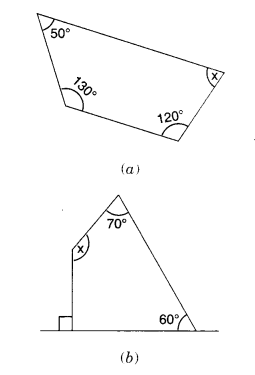
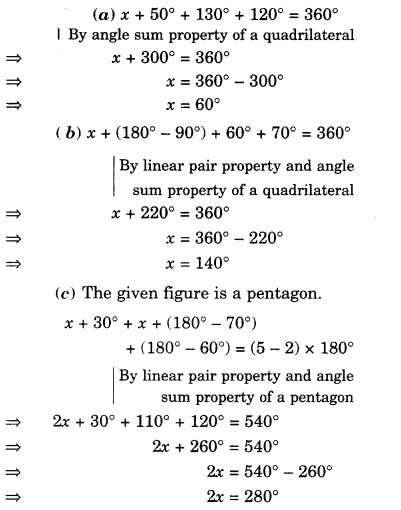
Solution.

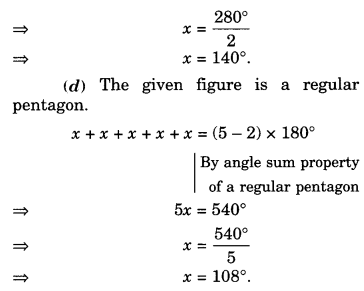
Question 7.
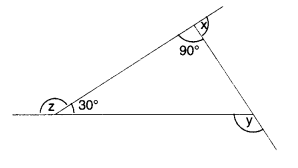
(a) Find x+y+z
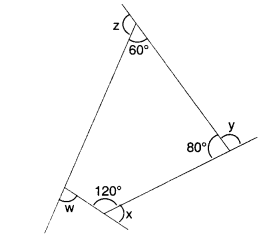
(b) Find x+y+z+w.
Solution.
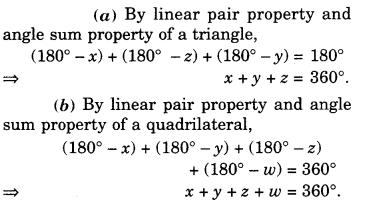
Understanding Quadrilaterals Ex 3.2
Question 1.
Find x in the following figures.
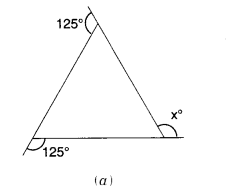
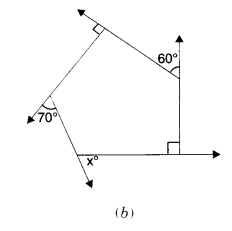
Solution.
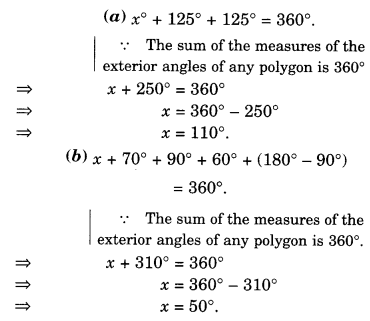
Question 2.
Find the measure of each exterior angle of a regular polygon of
- (i) 9 sides
- (ii) 15 sides
Solution.
(i) 9 sides
Measure of each exterior angle=360°/9=40°?
(ii) 15 slides
Measure of each exterior angle=360°/15=24°?
Question 3.
How many sides does a regular polygon have if the measure of an exterior angle is 24°?
Solution.
Let the number of sides be n. Then, n(24°)=360°.
? n=360°/24=15
Hence, the number of sides is 15.
Question 4.
How many sides does a regular polygon have if each of its interior angles is 165°?
Solution.
? Each interior angle=165°
∴ Each exterior angle
= 180°-165°=15°
linear pair property
Let the number of sides be n. Then,
n(15°)=360°
n=360°/15°=24
Hence, the number of sides is 24.
Question 5.
(a) Is it possible to have a regular polygon with a measure of each exterior angle at 22°?
(b) Can it be an interior angle of a regular polygon? Why?
Solution.
(a) No ; (since 22 is not a factor of 360).
(b) No ; (because each exterior angle is 180° - 22° = 158°, which is not a factor of 360°).
Question 6.
(a) What is the minimum interior angle possible for a regular polygon? Why?
(b) What is the maximum exterior angle possible for a regular polygon?
Solution.
(a) The equilateral triangle is a regular polygon of 3 sides has the minimum measure of an interior angle = 60°.
(b) By (a), we can see that the maximum exterior angle possible for a regular polygon is 180° – 60° = 120°.
Understanding Quadrilaterals Ex 3.3
Question 1.
Given a parallelogram ABCD. Complete each statement along with the definition with the definition or property used.

- (i) AD = ………
- (ii) ∠DCB = …………….
- (iii) OC = ……………….
- (iv) m∠DAB + m∠CDA = …………..
Solution.
(i) AD = BC
Opposite sides of a parallelogram are equal
(ii) ∠DCB = ∠DAB
Opposite angles of a parallelogram are equal
(iii) OC = OA
? Diagonals of a parallelogram bisect each other
(iv) m∠DAB + m∠CDA = 180°
? Adjacent angles of a parallelogram are supplementary.
Question 2.
Consider the following parallelo¬grams. Find the values of the unknowns x, y, z.
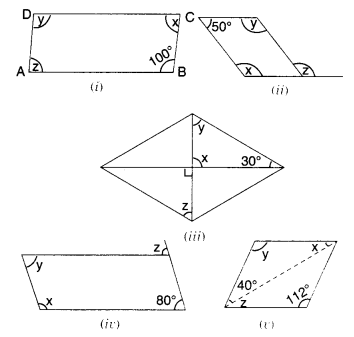
Solution.
(i) y = 100°
Opposite angles of a parallelogram are equal
x + 100° = 180°
Adjacent angles in a parallelogram are supplementary
⇒ x = 180° – 100°
⇒ x = 80°
⇒ z – x = 80°
Opposite angles of a parallelogram are of equal measure
(ii) x + 50° = 180°
Adjacent angles in a parallelogram are supplementary
⇒ x = 180° – 50° = 130°
⇒ y = x = 130°
The opposite angles of a parallelogram are of equal measure
180° – z = 50°
Opposite angles of a parallelogram are of equal measure
⇒ z = 180° – 50° = 130°
(iii) x = 90°
Vertically opposite angles are equal
x + y + 30° = 180°
By angle sum property of a triangle
⇒ 90° + y + 30° = 180°
⇒ 120° + y = 180°
⇒ y = 180° – 120° = 60° z + 30° + 90° – 180°
By angle sum property of a triangle
z = 60°
(iv) y = 80°
Opposite angles of a parallelogram are of equal measure
x + 80° = 180°
Adjacent angles in a parallelogram are supplementary
⇒ x = 180° – 80°
⇒ x = 100°
⇒ 180°-2+ 80°= 180°
Linear pair property and adjacent angles in a parallelogram are supplementary.
z = 80°
(v) y = 112°
Opposite angles of a parallelogram are equal
x + y + 40° = 180°
By angle sum property of a triangle
⇒ x + 112° + 40° = 180°
⇒ x + 152° = 180°
⇒ x = 180°- 152°
⇒ x = 28°
z = x = 28°.
Alternate interior angles
Question 3.
Can a quadrilateral ABCD be a parallelogram if
- (i) ∠D + ∠B = 180° ?
- (ii) AB = DC = 8 cm, AD = 4 cm and BC = 4.4 cm
- (iii) ∠A = 70° and ∠C = 65°?
Solution.
- (i) Can be, but need not be
- (ii) No: in a parallelogram, opposite sides are equal; but here, AD ≠ BC.
- (iii) No: in a parallelogram, opposite angles are of equal measure; but here ∠A ≠ ∠C.
Question 4.
Draw a rough figure of a quadrilateral that is not a parallelogram but has exactly two opposite angles of equal measure.
Solution.
A kite, for example
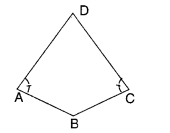
Question 5.
The measures of two adjacent angles of a parallelogram are in the ratio 3:2. Find the measure of each of the angles of the parallelogram.
Solution.
Let the two adjacent angles be 3x° and 2x°.
Then,
3x° + 2x° = 180°
∴ Sum of the two adjacent angles of a parallelogram is 180°
⇒ 5x° = 180°
? x?=180°/5
⇒ x° = 36°
⇒ 3x° = 3 x 36° = 108°
and
2x° = 2 x 36° = 72°.
Since, the opposite angles of a parallelogram are of equal measure, therefore the measures of the angles of the parallelogram are 72°, 108°, 72°, and 108°.
Question 6.
Two adjacent angles of a parallelogram have equal measure. Find the measure of each of the angles of the parallelogram.
Solution.
Let the two adjacent angles of a parallelogram be x° each.
Then,
x° + x° = 180°
∴ Sum of the two adjacent angles of a parallelogram is 180°.
⇒ 2x° = 180°
? x?=180°/2
⇒ x° = 90°.
Since the opposite angles of a parallelogram are of equal measure, therefore the measure of each of the angles of the parallelogram is 90°, i.e., each angle of the parallelogram is a right angle.
Question 7.
The adjacent figure HOPE is a parallelogram. Find the angle measures x, y and z. State the properties you use to find them.
Solution.
x = 180° – 70° = 110°
Linear pair property and the opposite angles of a parallelogram are of equal measure.
? HOPE is a || gm
∴ HE || OP
and HP is a transversal
∴ y = 40°
alternate interior angles
40° + z + x = 180°
The adjacent angles in a parallelogram are supplementary
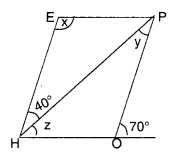
⇒ 40° + z + 110° = 180°
⇒ z + 150° = 180°
⇒ z = 180° – 150°
⇒ z = 30°.
Question 8.
The following figures GUNS and RUNS are parallelograms. Find x and y. (Lengths are in cm)
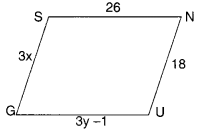
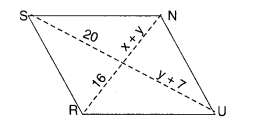
Solution.
(i)
For Figure GUNS
Since the opposite sides of a parallelogram are of equal length, therefore,
⇒ 3x = 18
? x=18/3=6
and, 3y – 1 = 26
⇒ 3y = 26 + 1
⇒ 3y = 27
y=27/3=9
Hence, x = 6; y = 9.
(ii)
For Figure RUNS
Since the diagonals of a parallelogram bisect each other, therefore,
⇒ x + y = 16 …(1)
and, y + 7 = 20 …(2)
From (2),
⇒ y – 20 – 7 = 13
Putting y = 13 in (1), we get
⇒ x + 13 = 16 ⇒ x = 16 – 13 = 3.
Hence, x = 3; y = 13.
Question 9.
In the below figure both RISK and CLUE are parallelograms. Find the value of x.
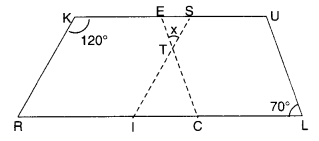
Solution.
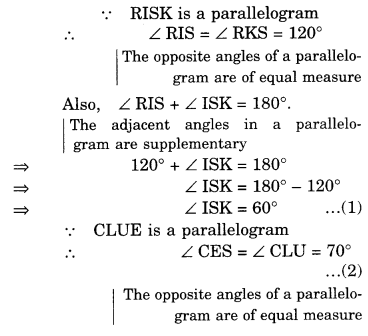
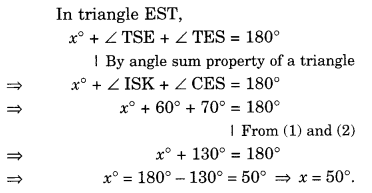
Question 10.
Explain how this figure is a trapezium. Which of its two sides is parallel?
Solution.
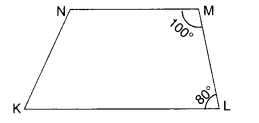
? KLM + ∠NML = 80° + 100° = 180°
∴ KL || NM
? The sum of consecutive interior angles is 180°
∴ Figure KLMN is a trapezium.
Its two sides KL¯¯¯¯¯¯¯¯ and NM¯¯¯¯¯¯¯¯¯¯ are parallel.
Question 11.
Find m∠C in the figure, if AB¯¯¯¯¯¯¯¯ || DC¯¯¯¯¯¯¯¯.
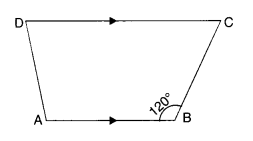
Solution.
?AB¯¯¯¯¯¯¯¯ || DC¯¯¯¯¯¯¯¯
∴ m∠C + m∠B = 180°
? The sum of consecutive interior angles is 180°
m∠C+ 120° = 180°
⇒ m∠C = 180° – 120° = 60°.
Question 12.
Find the measure of ∠P and ∠S, if SP¯¯¯¯¯¯¯ || RQ¯¯¯¯¯¯¯¯ in the figure. (If you find mZ R, is there more than one method to find
m∠P ?)
Solution.
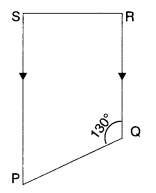
?sp;SP¯¯¯¯¯¯¯ || RQ¯¯¯¯¯¯¯¯
∴ m∠P+m∠Q = 180°
? The sum of consecutive interior angles is 180°
⇒ m∠P + 130° = 180°
⇒ m∠P = 180° – 130°
⇒ m∠P = 50°
Again, m∠R + m∠S = 180°
? The sum of consecutive interior angles is 180°
⇒ 90° + m Z S = 180°
⇒ m∠S = 180° – 90° = 90°
Yes; there is one more method of finding m∠P if m∠R is given and that is by using the angle sum property of a quadrilateral.
We have,
m∠P + m∠Q + m∠R + m∠S = 360°
⇒ m∠P + 130° + 90° + 90° = 360°
⇒ m∠P + 310° = 360°
⇒ m∠P = 360° – 310° = 50°.
Understanding Quadrilaterals Ex 3.4
Question 1.
State whether True or False :
- (a) All rectangles are squares
- (b) All rhombuses are parallelograms
- (c) All squares are rhombuses and also rectangles
- (d) All squares are not parallelograms
- (e) All kites are rhombuses
- (f) All rhombuses are kites
- (g) All parallelograms are trapeziums
- (h) All squares are trapeziums.
Solution.
(b), (c), (f), (g), (h) are true;
others are false.
Question 2.
Identify all the quadrilaterals that have.
- (a) four sides of equal length
- (b) four right angles
Solution.
- (a) Rhombus; square
- (b) Square; rectangle
Question 3.
Explain how a square is
- (i) a quadrilateral
- (ii)a parallelogram
- (iii) a rhombus
- (iv) a rectangle.
Solution.
(i) a quadrilateral
A square is 4 sided, so it is a quadrilateral.
(ii) a parallelogram
A square has its opposite sides parallel; so it is a parallelogram.
(iii) a rhombus
A square is a parallelogram with all the 4 sides equal, so it is a rhombus.
(iv) a rectangle
A square is a parallelogram with each angle a right angle; so it is a rectangle.
Question 4.
Name the quadrilaterals whose diagonals :
- (i) bisect each other
- (ii) are perpendicular bisectors of each other
- (iii) are equal.
Solution.
(i) bisect each other
The names of the quadrilaterals whose diagonals bisect each other are parallelogram; rhombus; square; rectangle.
(ii) are perpendicular bisectors of each other
The names of the quadrilaterals whose diagonals are perpendicular bisectors of each other are rhombus; square.
(iii) are equal
The names of the quadrilaterals whose diagonals are equal are square; rectangle.
Question 5.
Explain why a rectangle is a convex quadrilateral.
Solution.
A rectangle is a convex quadrilateral because both of its diagonals lie wholly in its interior.
Question 6.
ABC is a right-angled triangle and O is the mid-point of the side opposite to the right angle. Explain why O is equidistant from A, B and C. (The dotted lines are drawn additionally to help you).
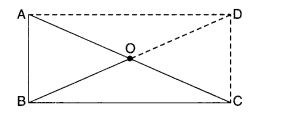
Solution.
Construction: Produce BO to D such that BO = OD. Join AD and CD.
Proof. AO = OC ? O is the mid-point of AC
BO = OD By construction
∴ Diagonals of quadrilateral ABCD bisect each other.
∴ Quadrilateral ABCD is a parallelogram.
Now, ∠ABC = 90° given
∴ ABCD is a rectangle.
Since the diagonals of a rectangle bisect each other, therefore,
O is the mid-point of AC and BD both. But AC = BD
? Diagonals of a rectangle are equal
∴ OA = OC =12AC =12BD = OB
⇒ OA = OB = OC.